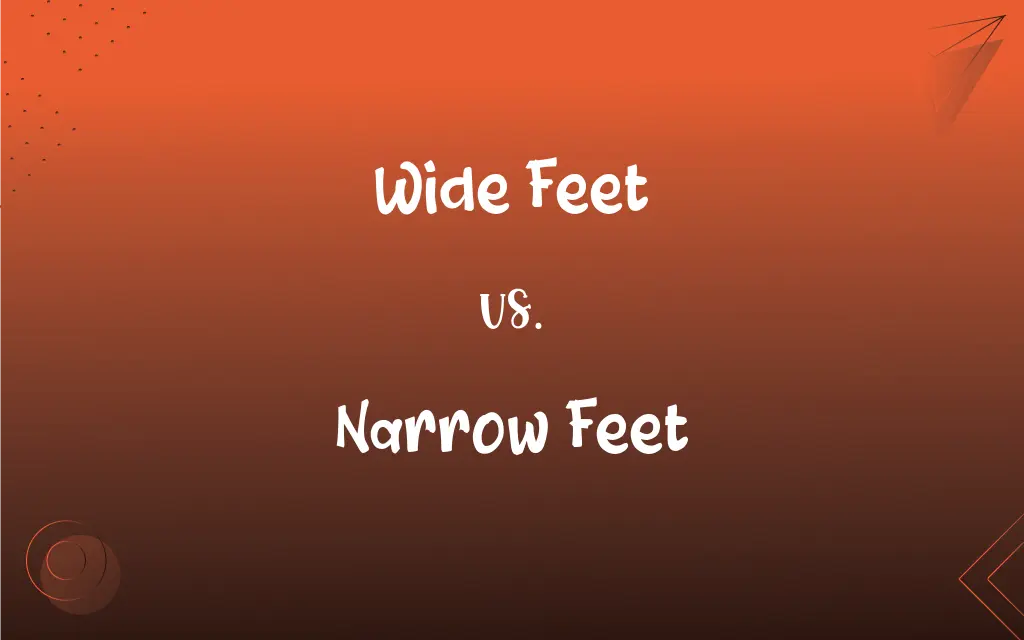Wide Feet vs. Narrow Feet: What's the Difference?
Edited by Harlon Moss || By Janet White || Published on November 24, 2023
Wide feet are broader across the ball of the foot, while narrow feet are slimmer across the same region.

Key Differences
Wide Feet and Narrow Feet: When considering the structure of feet, wide feet are typically characterized by a broader width across the ball of the foot. On the other hand, narrow feet have a more slender profile across the ball, making for a more elongated appearance.
Shoe Fitting: For those with wide feet, standard shoes might often feel tight or uncomfortable, necessitating the need for specially designed wide-fit shoes. Conversely, individuals with narrow feet might find that standard shoes feel too loose, leading them to seek shoes with narrow fittings.
Causes: The width of a person's feet, whether wide or narrow, can be attributed to genetics, bone structure, and even certain medical conditions. Some people naturally have wide feet from birth, while others might have narrow feet due to their genetic makeup.
Implications: Those with wide feet might experience more friction in tight shoes, leading to issues like calluses or blisters. People with narrow feet, on the other hand, may often struggle to find shoes that provide adequate support, as standard shoes might not fit snugly.
Adjustments: Inserts and orthotics are commonly recommended for both wide and narrow feet. For wide feet, they can provide cushioning and reduce friction. For narrow feet, they can offer additional support and snugness.
ADVERTISEMENT
Comparison Chart
Appearance
Broader across the ball of the foot.
Slimmer across the ball of the foot.
Shoe Fit
Requires wide-fit shoes.
Benefits from narrow-fit shoes.
Common Issues
Calluses, blisters from tight shoes.
Lack of support in standard shoes.
Causes
Genetics, bone structure, medical issues.
Primarily genetics and bone structure.
Solutions
Inserts, wide-fit shoes.
Inserts, narrow-fit shoes.
ADVERTISEMENT
Wide Feet and Narrow Feet Definitions
Wide Feet
Feet that have a broader width, especially across the ball.
She has wide feet, so she often opts for custom-made shoes.
Narrow Feet
Feet with a reduced span across their central part.
People with narrow feet might need shoe inserts for better support.
Wide Feet
Feet where the metatarsal region is noticeably wide.
Due to her wide feet, ballet flats never fit her comfortably.
Narrow Feet
Feet where the metatarsal region is comparatively slim.
With her narrow feet, strappy sandals fit her best.
Wide Feet
Feet with an increased span across their central part.
Wide feet can sometimes lead to discomfort in standard shoes.
Narrow Feet
Feet that are slender across the ball.
He has narrow feet, making it a challenge to find snug-fitting shoes.
Wide Feet
A foot shape where the breadth is relatively larger compared to its length.
Because of his wide feet, he needs shoes with a broader fit.
Narrow Feet
A foot type characterized by limited horizontal dimensions.
Sneakers often feel loose to him due to his narrow feet.
Wide Feet
A foot type characterized by expanded dimensions horizontally.
Her wide feet mean she often shops in specialized shoe stores.
Narrow Feet
A foot shape where the breadth is minimal relative to its length.
Narrow feet often require specific shoe types for a comfortable fit.
FAQs
What do "wide feet" refer to?
Wide feet describe a foot shape that's broader, especially across the ball of the foot.
Do people with wide feet experience shoe discomfort more often?
Those with wide feet might find standard shoes tight, leading to discomfort or foot problems like blisters.
What are "narrow feet"?
Narrow feet pertain to feet that are slimmer across the ball, often appearing more elongated.
Is it harder to find shoes for narrow feet?
Yes, individuals with narrow feet might struggle to find snug-fitting shoes, as standard ones may feel too loose.
Can inserts help individuals with narrow feet?
Absolutely! Inserts can provide additional support and snugness for narrow feet in standard shoes.
Are there specific shoe brands known for catering to wide feet?
Yes, several brands offer wide-fit shoe options specifically designed for broader feet.
Can foot exercises alter the width of your feet?
While exercises can strengthen foot muscles, they're unlikely to significantly change foot width.
Are wide feet and narrow feet genetic traits?
Yes, both can be inherited traits, but they might also result from factors like bone structure or medical conditions.
Can the width of your feet change over time?
Yes, factors like weight gain, pregnancy, or certain medical conditions can alter foot width.
Is there a way to measure if one has wide or narrow feet?
Yes, foot width can be measured using a Brannock device or at specialized shoe stores.
Can shoes be stretched to accommodate wide feet?
Yes, some shoes can be stretched slightly, but it's better to opt for wide-fit shoes for consistent comfort.
Are wide or narrow feet linked to certain foot problems?
Wide feet may lead to blisters or calluses in tight shoes, while narrow feet might lack support in standard shoes.
Can footwear like high heels impact foot width?
Yes, consistently wearing tight or ill-fitting shoes like high heels can contribute to foot issues and possibly affect width.
Can orthotics be beneficial for both wide and narrow feet?
Yes, orthotics can offer cushioning and support tailored to the specific needs of both wide and narrow feet.
Do most shoe stores cater to both wide and narrow feet varieties?
While many stores carry standard widths, specialized shoe stores might offer a broader range of widths for both wide and narrow feet.
How can one care for wide or narrow feet?
Choosing well-fitted shoes, using inserts if needed, and regular foot care routines can help maintain foot health.
Do narrow feet require special athletic shoes?
While not always necessary, shoes with a narrower fit might provide better support during athletic activities for those with narrow feet.
How common are wide feet and narrow feet?
Both variations are common, but the prevalence varies among populations and is influenced by genetics and environmental factors.
Are children more likely to have narrow feet?
Not necessarily. Foot width in children varies, and some might outgrow their foot width as they age.
Is there a correlation between foot length and width?
Not always. It's entirely possible for someone to have long narrow feet or short wide feet, and any combination in between.
About Author
Written by
Janet WhiteJanet White has been an esteemed writer and blogger for Difference Wiki. Holding a Master's degree in Science and Medical Journalism from the prestigious Boston University, she has consistently demonstrated her expertise and passion for her field. When she's not immersed in her work, Janet relishes her time exercising, delving into a good book, and cherishing moments with friends and family.
Edited by
Harlon MossHarlon is a seasoned quality moderator and accomplished content writer for Difference Wiki. An alumnus of the prestigious University of California, he earned his degree in Computer Science. Leveraging his academic background, Harlon brings a meticulous and informed perspective to his work, ensuring content accuracy and excellence.






































































